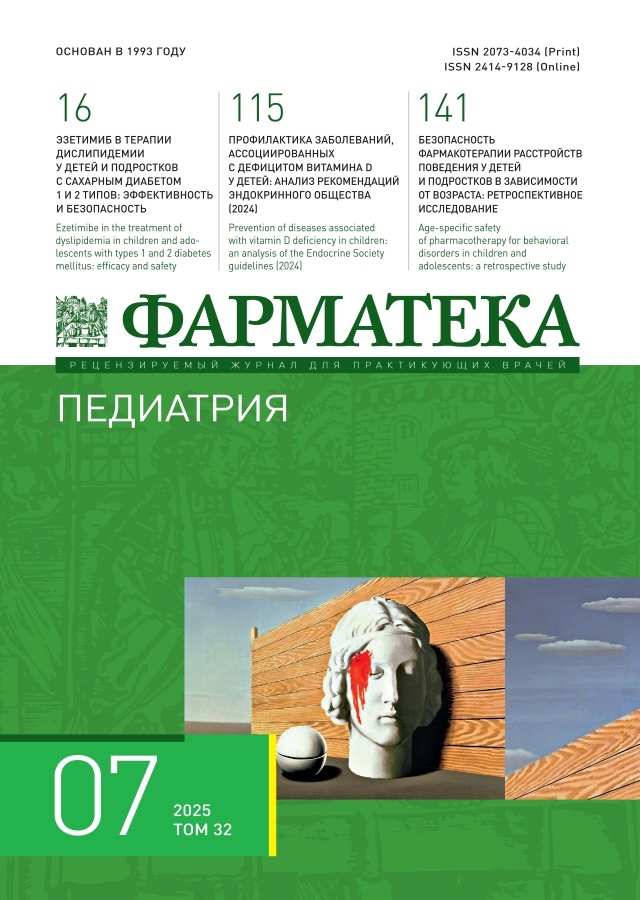Modifiable and non-modifiable risk factors for vitamin d deficiency in infants and young children
- Autores: Vorobeva O.A.1, Drozdov V.N.1, Kazakov R.E.2, Fedorova T.A.1, Shikh E.V.1
-
Afiliações:
- I.M. Sechenov First Moscow State Medical University (Sechenov University)
- Scientific Center for Expertise of Medical Products
- Edição: Volume 32, Nº 7 (2025)
- Páginas: 123-130
- Seção: Original articles
- URL: https://journals.eco-vector.com/2073-4034/article/view/693749
- DOI: https://doi.org/10.18565/pharmateca.2025.7.123-130
- ID: 693749
Citar
Texto integral
Resumo
Background: The high prevalence of vitamin D deficiency in children necessitates finding optimal approaches to prevention, which in turn is impossible without identifying risk factors, including in different age groups.
Objective: Determination of the contribution of modifiable risk factors and the role of genotypes of polymorphic markers Fok I and Taq I of the VDR gene in the development of vitamin D deficiency in infants and young children.
Materials and methods: 94 children aged 4.5 to 18 months were examined. The study included determination of blood vitamin D levels (25-hydroxyergocalciferol + 25-hydroxycholecalciferol), determination of Fok I and Taq I polymorphisms of the VDR gene. The following anamnestic data were analyzed: maternal intake of vitamin D during pregnancy, type of feeding, consistency of drug prophylaxis of vitamin D deficiency in children. For each of the listed factors, the risk levels (and their statistical significance) for the development of vitamin D deficiency were determined.
Results: With seasonal intake of vitamin D, the risk of a decrease in plasma 25-OH-D to a level of less than 30 ng/ml increased by 10.36 times (p=0.0001) compared with year-round prophylaxis; refusal of maternal vitamin D intake during pregnancy resulted in a 2.95-fold (p=0.006) increase in the risk of vitamin D deficiency compared to children whose mothers took vitamin D during pregnancy. Breastfeeding did not statistically significantly increase the risk of vitamin D deficiency in children. It was found that homozygous carriers of minor alleles of Fok I (TT) had a 2.67-fold increase in the risk of developing this condition (p=0.015).
Conclusion: Modifiable risk factors are of the greatest importance. Irregularity of drug prophylaxis of vitamin D deficiency (seasonal intake) and refusal to take vitamin D during pregnancy increase the risk of vitamin D deficiency in infants and young children. Homozygous carriage of minor alleles of the Fok I gene does not correlate with the blood vitamin D level in the of children, but increases the risk of developing vitamin D deficiency.
Texto integral
Sobre autores
Olga Vorobeva
I.M. Sechenov First Moscow State Medical University (Sechenov University)
Autor responsável pela correspondência
Email: vorobeva_o_a@staff.sechenov.ru
ORCID ID: 0000-0001-9292-4769
Teaching Assistant of the Department of Clinical Pharmacology and Propaedeutics of Internal Diseases, N.V. Sklifosovsky Institute of Clinical Medicine
Rússia, MoscowVladimir Drozdov
I.M. Sechenov First Moscow State Medical University (Sechenov University)
Email: vorobeva_o_a@staff.sechenov.ru
ORCID ID: 0000-0002-0535-2916
Dr. Sci. (Med.), Professor, Department of Clinical Pharmacology and Propaedeutics of Internal Diseases, N.V. Sklifosovsky Institute of Clinical Medicine
Rússia, MoscowRuslan Kazakov
Scientific Center for Expertise of Medical Products
Email: vorobeva_o_a@staff.sechenov.ru
ORCID ID: 0000-0003-0802-4229
Cand. Sci. (Biol.), Head of the Department of Personalized Medicine and Clinical Pharmacogenetics
Rússia, MoscowTatiana Fedorova
I.M. Sechenov First Moscow State Medical University (Sechenov University)
Email: vorobeva_o_a@staff.sechenov.ru
ORCID ID: 0000-0003-1762-6934
Department of Clinical Pharmacology and Propaedeutics of Internal Medicine, N.V. Sklifosovsky Institute of Clinical Medicine
Rússia, MoscowEvgenia Shikh
I.M. Sechenov First Moscow State Medical University (Sechenov University)
Email: vorobeva_o_a@staff.sechenov.ru
ORCID ID: 0000-0001-6589-7654
Dr. Sci. (Med.), Corresponding Member of the Russian Academy of Sciences, Head of the Department of Clinical Pharmacology and Propaedeutics of Internal Medicine, N.V. Sklifosovsky Institute of Clinical Medicine
Rússia, MoscowBibliografia
- Fischer P.R., Johnson C.R., Leopold K.N., Thacher T.D. Treatment of vitamin D deficiency in children. Expert Rev Endocrinol Metab. 2023;18(6):489–502. https://dx.doi.org/10.1080/17446651.2023.2270053
- Lips P., Cashman K.D., Lamberg-Allardt C., et al. Current vitamin D status in European and Middle East countries and strategies to prevent vitamin D deficiency: a position statement of the European Calcified Tissue Society. Eur J Endocrinol. 2019;180:P23–P54. https://dx.doi.org/10.1530/EJE-18-0736
- Bouillon R., Marcocci C., Carmeliet G., et al. Skeletal and extraskeletal actions of vitamin D: current evidence and outstanding questions. Endocr Rev. 2019;40:1109–1151. https://dx.doi.org/10.1210/er.2018-00126
- Wagner C.L., Hollis B.W. The extraordinary metabolism of vitamin D. Elife. 2022;11:e77539. https://dx.doi.org/10.7554/eLife.77539
- Sotunde O.F., Laliberte A., Weiler H.A. Maternal risk factors and newborn infant vitamin D status: a scoping literature review. Nutr Res. 2019;63:1–20. https://dx.doi.org/10.1016/j.nutres.2018.11.011
- Saraf R., Morton S.M., Camargo C.A. Jr, Grant C.C. Global summary of maternal and newborn vitamin D status – a systematic review. Matern Child Nutr. 2016;12(4):647–668. https://dx.doi.org/10.1111/mcn.12210
- van der Pligt P., Willcox J., Szymlek-Gay E.A., et al. Associations of Maternal Vitamin D Deficiency with Pregnancy and Neonatal Complications in Developing Countries: A Systematic Review. Nutrients. 2018;10(5):640. https://dx.doi.org/10.3390/nu10050640
- Song S.J., Si S., Liu J., et al. Vitamin D status in Chinese pregnant women and their newborns in Beijing and their relationships to birth size. Public Health Nutr. 2013;16(4):687–692. https://dx.doi.org/10.1017/S1368980012003084
- Tan M.L., Abrams S.A., Osborn D.A. Vitamin D supplementation for term breastfed infants to prevent vitamin D deficiency and improve bone health. Cochrane Database Syst Rev. 2020;12(12):CD013046. https://dx.doi.org/10.1002/14651858.CD013046.pub2
- Tayel S.I., Soliman S.E., Elsayed H.M. Vitamin D deficiency and vitamin D receptor variants in mothers and their neonates are risk factors for neonatal sepsis. Steroids. 2018;134:37–42. https://dx.doi.org/10.1016/j.steroids.2018.03
- Coşkun S., Şimşek Ş., Camkurt M.A., Çim A., Çelik S.B. Association of polymorphisms in the vitamin D receptor gene and serum 25-hydroxyvitamin D levels in children with autism spectrum disorder. Gene. 2016;588(2):109–114. https://dx.doi.org/10.1016/j.gene.2016.05.004
Arquivos suplementares









